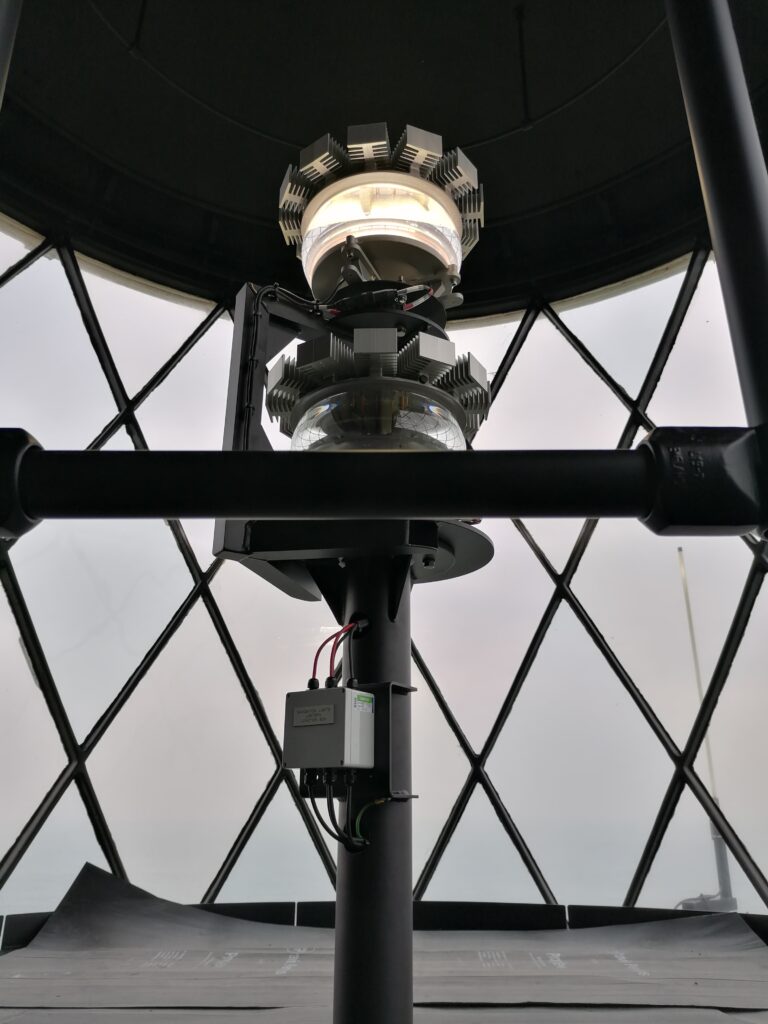Trinity House – St Catherine’s Lighthouse upgrade
The lighthouse at St Catherine’s on the southern tip of the Isle of Wight (England, South Coast), occupies a position that makes it a key waypoint and works with Portland Bill and Needles lighthouses to the west and Nab Tower and Beachy Head lighthouses to the east to aid vessels navigating in the English Channel and approaching the Solent.
An earlier automation
The existing aids to navigation dated from a 1997 automation project and much of the equipment was considered to be obsolete and required replacement. A project to modernise the lighthouse was initiated in 2019 for completion in March 2022.
Removal of mercury
As with many lighthouse modernisation projects, one of the critical success factors is the removal of hazardous substances and materials. At St Catherine’s, this included the mercury, which was relied upon to rotate the Second Order Optic. Prior to the modernisation, this optic had exhibited its unique flash character (1 flash every 5 seconds) at the required range of 25NM for over 100 years. However, with the installation of modern flashing LED lanterns, the lighthouse can now achieve its navigation requirement without relying on the hazardous mercury.
The optic was removed and a new Lantern Room platform installed – requiring Listed Building Consent due to the station’s Grade II listing. These activities required careful planning and execution due the size and weight of the elements involved, with the dismantled sections of the optic alone totalling 1800kg and the combined weight of the mercury and transportation flasks were 650kg. These tasks were aided by the assistance of a crane which had to be very carefully manoeuvred down the heavily restricted access road – a challenge in itself.
Good access for maintenance
Design of the Lantern Room platform now affords maintenance teams excellent access around the new lantern pedestal and a means of cleaning and replacing sections of the lantern room glazing panels. The lantern pedestal securely supports two Vega VLB92 type lanterns, configured as a main and standby, which deliver the 18NM navigation requirement.
Further down the tower, a much consolidated electrical system comprising Trinity House standard telemetry, power and lantern control cubicles deliver a reduced maintenance requirement. Much of this is housed within the Service Room alongside a newly installed Trinity House standard RSL200 Sector Light. This light replaces the previous obsolete light source and still exhibits the 17 degree red sector with a range of 13NM and marks the Atherfield Ledge to the west of the lighthouse towards the Needles.
Elsewhere on the site, a new position for third-party equipment has allowed the removal of a deteriorated GRP building on the site and will eventually mean that access will no longer be required to one of the outbuildings that lies close to the eroding cliff edge.
Closure of DGPS
In anticipation of the discontinuation of the DGPS system at this station, the backup TS3 engine and fuel system were removed from the Day Facilities building and returned to Harwich Depot. A further project followed to remove the remaining DGPS infrastructure when that system was turned off on 31 March 2022. Other equipment to be removed includes the main and standby beacon masts and the gantry structure on the lighthouse gallery.
The build-up to the execution of this project was significantly hampered by the Covid-19 pandemic and the associated lockdowns. Add to that, a disruption to resource availability caused by other projects being delivered concurrently, the Trinity House teams and the installation contractors deserve great credit for completing these works on time and largely to budget.

The light source. The lantern pedestal securely supports two Vega VLB92 type
lanterns, configured as a main and standby, which deliver the 18NM navigation
requirement.

St Catherine’s on the southern tip of the Isle of Wight, occupies a position that makes it a key waypoint and works with Portland Bill and Needles lighthouses to the west and Nab Tower and Beachy Head lighthouses to the east. The two towers are known as the cow and calf.
